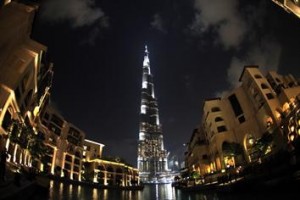By Angela Giuffrida www.thenational.ae
Catherine Hislop was wary at first about moving to the 27-storey The Lofts in Dubai’s trendy Downtown development.

Ms Hislop, 31, a recruitment consultant from London, had recently seen The Towering Inferno, a 1970s film about a skyscraper going up in flames, and wondered if she would be better off renewing the lease on her shared villa in Umm Suqeim.
But once she saw the stunning view of the Burj Khalifa, the tallest tower in the world, from the balcony of her one-bedroom apartment on the 10th floor, the fear quickly subsided. Now she would not swap her apartment for all the villas in Dubai.
“It was nice to live close to the beach for a year but I’ve always been a city person and it’s great having places like Dubai Mall and Souq al Bahar on your doorstep,” Ms Hislop says.
“There’s also a good mix of low and high-rise buildings here so you don’t feel as if you’re crammed in. I hardly use my car at the weekends now.”
With the Dubai Fountain and Burj Khalifa pulling in hundreds of tourists each day, Downtown has come into its own in the past year. The restaurants and shops that mark the waterway alongside Souq al Bahar in the Old Town throng with customers day and night, creating an urban vibe.
“Downtown is a hot property at the moment, with it being new and the lifestyle that it offers,” says John Davis, the Middle East chief executive of the property consultancy Colliers International.
Enjoying this lifestyle, and with an address to brag about, was once the realm of the privileged few. But a sharp decline in property prices and rents of as much as 50 per cent has made places such as Downtown more affordable, enabling middle-income earners such as Ms Hislop to rent her own place there.
It costs between Dh70,000 (US$19,058) and Dh90,000 a year for a one-bedroom apartment in new buildings such as The Lofts and Burj Views – almost half the rental price of Downtown two years ago.
“I’d got to the point where I’d had enough of sharing; prices have come down so much and landlords are more willing to negotiate,” says Ms Hislop.
Up until a few years ago, Dubai tower living was mainly concentrated around the Trade Centre area of Sheikh Zayed Road. Since then, popular areas such as Dubai Marina and Jumeirah Lake Towers have mushroomed, while residential towers in Business Bay, just behind Downtown, are starting to come on stream.
While Jumeirah Lake Towers might not be as hip as Downtown, it draws a crowd from Abu Dhabi due to its location, says Charles Neil, the chief executive of the estate agent Landmark Properties. It is also a lot cheaper, as a one-bedroom flat can be rented for as little as Dh45,000 a year.
“Jumeirah Lake Towers is popular and is filling up … price is also very important,” says Mr Neil.
But fast-paced living in the sky is not for everyone, says Andy Dukes, who lives in a villa on Palm Jumeirah.
The former owner of an e-greeting business from London was one of the first people to move on to The Palm in 2007, when there were few amenities.
Mr Dukes owns two four-bedroom villas, one in which he lives and the other he rents out. Each has its own private beach.
He lives alone and spends his spare time walking along the beach or kayaking, and has seen The Palm come to life since moving in.
“What has changed phenomenally is that the facilities here have gone from being very limited to a number of things that have opened,” Mr Dukes says.
“There are restaurants at the Shoreline Apartments, three ATMs, a bakery, mini-marts, a flower shop and a 24-hour deli. All of this has happened within the last couple of years. And more facilities will open up as more buildings open.”
But while prices have fallen on The Palm, you still need to be on a good salary to afford the rent, with the cheapest one-bedroom apartment costing about Dh90,000 a year.
Hassan Haroon and his family have the best of both worlds. They live in a three-bedroom apartment at the plaza level of Jumeirah Beach Residences, where there is a shaded courtyard with shops and cafes. Jumeirah Beach Residences is a development of about 40 towers.
Mr Haroon, a banker and father of one from Pakistan, has a short stroll down to The Walk on the ground level – another bustling area of street cafes – and is just across the road from the beach.
“There’s a great sense of community living on the plaza level,” he says. “We have a fountain and lots of greenery. “It’s away from the main road, so there are no cars or any other intrusions.”
Mr Haroon has a partial view of the sea from his apartment and says the development brings back memories of Montreal, Canada, where he lived before coming to Dubai in 2007.
“Jumeirah Beach Residences feels like home, whereas other areas, like Downtown, would feel more as if you’re living in a hotel. I wouldn’t change it,” he says.
Whether you live in a tower or villa, it’s a question of lifestyle choice, says Mr Neil, with trends now being influenced by the drop in prices and greater availability of property.
“Places like Downtown are popular but so are villa communities like The Springs and The Meadows, and a lot of projects are opening up further out of town in places like Mirdif, where prices are very attractive,” he says.
“Families tend to prefer villas for the space. Previously they were forced to live in apartments because villas were unaffordable. Amenities are also very important, some projects are less mature than others.”













